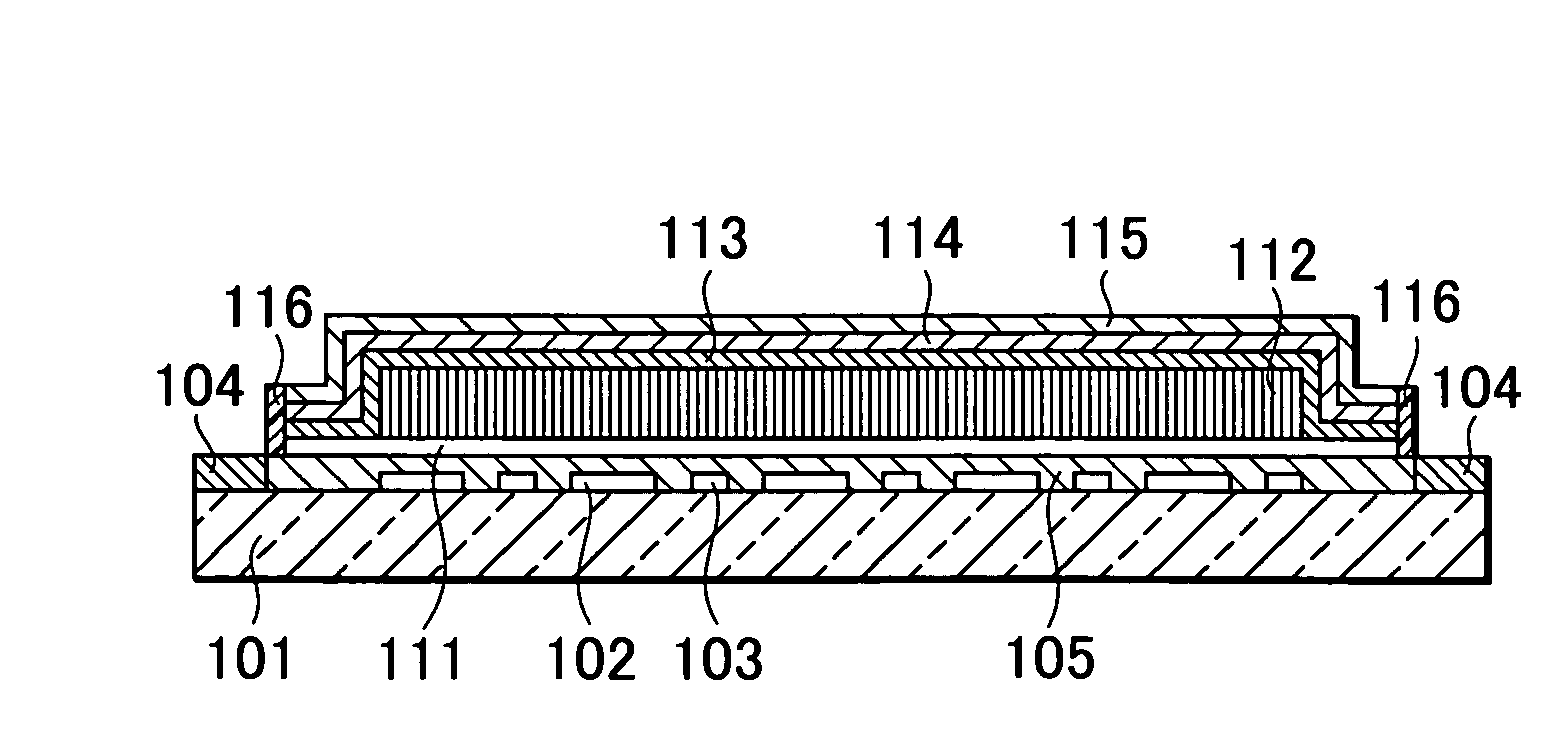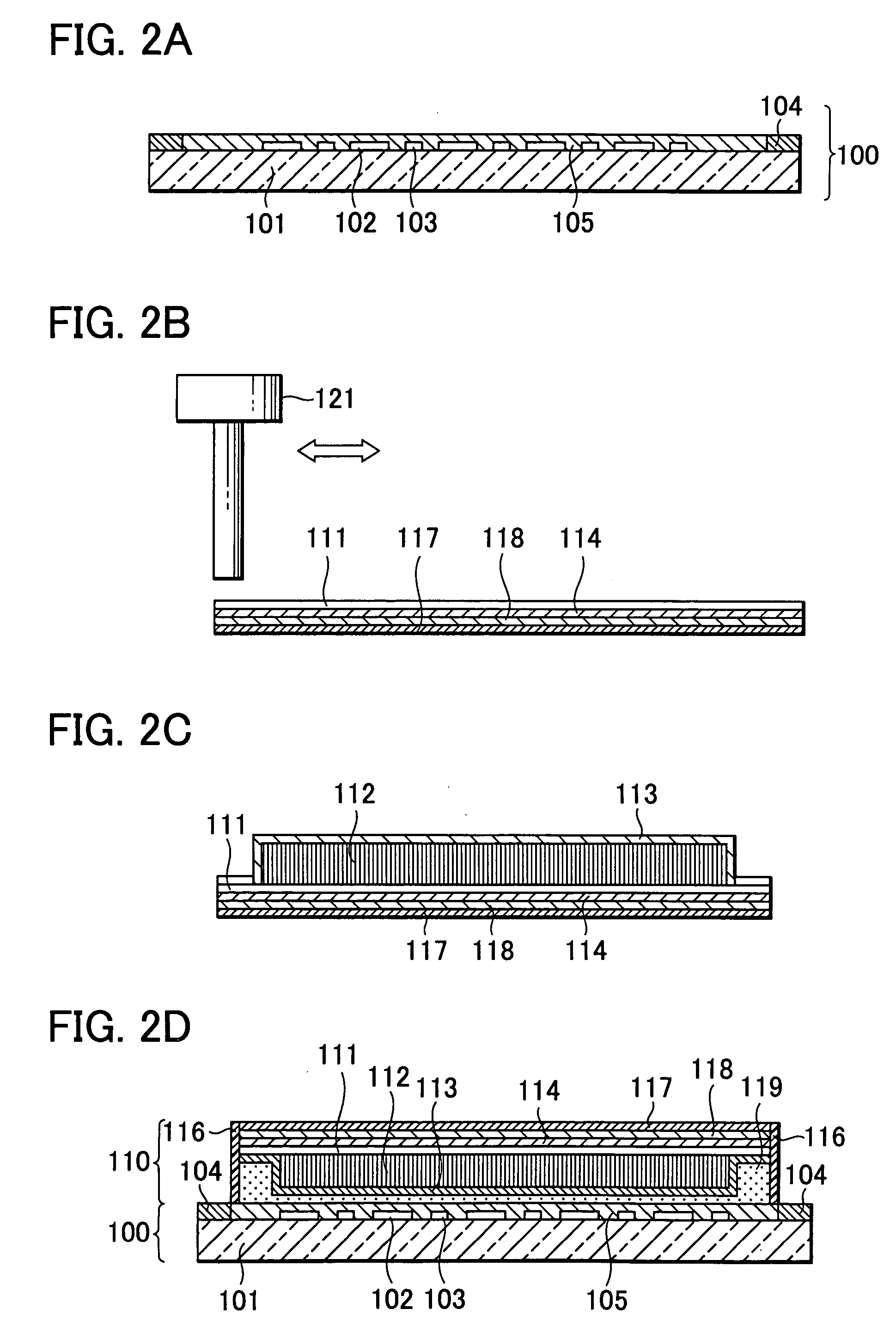Radiation detecting apparatus and method for manufacturing the same
a technology of radiation detection and detecting apparatus, which is applied in the direction of radiation measurement, measurement devices, instruments, etc., can solve the problems of long vacuum plasma treatment time, inability to reform the surface of the underlayer without damaging the sensor panel, and high current of photoelectric conversion devices, so as to prevent peeling, uniform optical conversion efficiency, and high precision of columnar crystals
- Summary
- Abstract
- Description
- Claims
- Application Information
AI Technical Summary
Benefits of technology
Problems solved by technology
Method used
Image
Examples
first embodiment
[0025]FIGS. 1A to 1C are sectional views showing the process steps for manufacturing a radiation detecting apparatus according to a first embodiment of the present invention.
[0026]As shown in FIG. 1A, a sensor panel 100 includes: an insulative glass substrate 101; photoelectric conversion devices 102, each including an amorphous silicon photosensor and a TFT; wires 103; lead-out portions 104; and a passivation layer 105 of, for example, silicon nitride, which is provided to cover the photoelectric conversion devices 102. A resin underlayer 111 of a phosphor layer 112 lies on the sensor panel 100. The underlayer 111 doubles as a protective layer for protecting the stiffness of the photoelectric conversion devices 102. The photoelectric conversion devices 102 are two-dimensionally arranged corresponding to pixels. The passivation layer 105 and the underlayer 111 may be referred to as a first protective layer and a second protective layer, respectively.
[0027]A surface of the underlayer...
second embodiment
[0038]The radiation detecting apparatus of the present invention may include a sensor panel having two-dimensionally arranged photoelectric conversion devices and a scintillator panel that are bonded together. The scintillator panel includes an underlayer of a phosphor layer over a substrate, where the phosphor layer is in contact with the underlayer. The surface of the underlayer contacting the phosphor layer is subjected to atmospheric pressure plasma treatment. The adhesion of the underlayer to the phosphor layer can be enhanced, and the diameter of the columnar crystals in the phosphor layer can be controlled, in the same manner as when the underlayer on the sensor panel is surface-treated.
[0039]FIGS. 2A to 2D are sectional views showing process steps for manufacturing a radiation detecting apparatus according to a second embodiment of the present invention.
[0040]FIG. 2A shows a sensor panel 100 of the radiation detecting apparatus. The sensor panel 100 includes an insulative gl...
third embodiment
[0044]FIG. 3 is a representation of a radiodiagnosis system using a radiation detecting apparatus, according to a third embodiment of the present invention.
[0045]X-rays 6060 generated from an x-ray tube 6050 pass through the chest 6062 of a test subject 6061, and enter a radiation detecting apparatus 6040 as shown in FIGS. 2A to 2D. The incoming X-rays include in-vivo information of the subject 6061. The phosphor layer emits light according to the incoming X-rays. The light is converted into electrical signals in the photoelectric conversion devices of the sensor panel and, thus, electrical information is obtained. This information is converted into digital information, and is subsequently processed into an image by an image processor 6070. The image is shown on a display 6080 in a control room.
[0046]The information can be transferred to a remote site through transmitting means, such as a telephone line 6090. Thus, the information can be shown on a display 6081 in a doctor's room ap...
PUM
 Login to View More
Login to View More Abstract
Description
Claims
Application Information
 Login to View More
Login to View More - R&D
- Intellectual Property
- Life Sciences
- Materials
- Tech Scout
- Unparalleled Data Quality
- Higher Quality Content
- 60% Fewer Hallucinations
Browse by: Latest US Patents, China's latest patents, Technical Efficacy Thesaurus, Application Domain, Technology Topic, Popular Technical Reports.
© 2025 PatSnap. All rights reserved.Legal|Privacy policy|Modern Slavery Act Transparency Statement|Sitemap|About US| Contact US: help@patsnap.com



